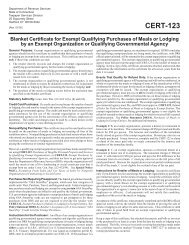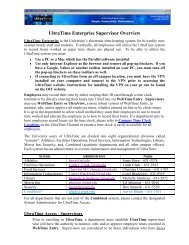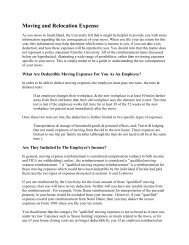2001 - Controller - University of Notre Dame
2001 - Controller - University of Notre Dame
2001 - Controller - University of Notre Dame
Create successful ePaper yourself
Turn your PDF publications into a flip-book with our unique Google optimized e-Paper software.
Amortization <strong>of</strong> the discount is recorded as additional contribution revenue. Allowance is made for uncollectible<br />
contributions based upon management’s expectations regarding collection <strong>of</strong> outstanding promises to give and<br />
the <strong>University</strong>’s collection experience.<br />
AUXILIARY ENTERPRISES<br />
The <strong>University</strong>’s auxiliary enterprises exist primarily to furnish goods and services to students, faculty and<br />
staff. Managed as essentially self-supporting activities, the <strong>University</strong>’s auxiliaries consist principally <strong>of</strong> residence<br />
halls, dining halls, intercollegiate athletics and college stores. Auxiliary enterprise revenues and fully<br />
costed expenses are reported as changes in unrestricted net assets.<br />
CASH AND CASH EQUIVALENTS<br />
Resources invested in money market funds and short-term investments with maturities at date <strong>of</strong> purchase<br />
<strong>of</strong> three months or less are classified as cash equivalents, except that any such investments purchased by external<br />
investment managers are classified as investments.<br />
42<br />
INVESTMENTS<br />
Valuation<br />
Investments are stated at fair value and are recorded on the trade or contract date. The estimated fair value<br />
<strong>of</strong> investments is based on quoted market prices, except for certain investments for which quoted market prices<br />
are not available.<br />
The estimated fair value <strong>of</strong> limited partnership and similar interests is based on valuations provided by the<br />
external investment managers as <strong>of</strong> March 31, adjusted for cash receipts, cash disbursements and securities<br />
distributions through June 30. The <strong>University</strong> believes the carrying amount <strong>of</strong> these financial instruments is a<br />
reasonable estimate <strong>of</strong> fair value. Because the limited partnership investments are not readily marketable, their<br />
estimated value is subject to uncertainty and therefore may differ from the value that would have been used had<br />
a ready market for such investments existed. Such difference could be material.<br />
The value <strong>of</strong> forward foreign currency exchange contracts is estimated using available market quotations<br />
obtained from banks and foreign exchange dealers. The change in market value <strong>of</strong> all foreign currency exchange<br />
contracts is recorded as unrealized gain or loss on foreign currency contracts in the statement <strong>of</strong> unrestricted<br />
revenues, expenses and other changes in unrestricted net assets. The fair value <strong>of</strong> these contracts is reported on<br />
a net-by-counterparty basis in the statement <strong>of</strong> financial position where management believes a legal right <strong>of</strong><br />
<strong>of</strong>fset exists under an enforceable netting agreement.<br />
Open futures and options contracts are valued at the closing exchange quotations on the last business day<br />
<strong>of</strong> the year. Brokerage commissions on open positions are accrued as a liability <strong>of</strong> the <strong>University</strong> in full upon the<br />
initiation <strong>of</strong> such open positions. Upon entering into futures contracts, the <strong>University</strong> is required to pledge to<br />
the broker an amount <strong>of</strong> cash or securities equal to the minimum initial margin requirements <strong>of</strong> the exchange<br />
on which the contracts are traded. New contracts and changes in margin requirements resulting from changes<br />
in the fair value <strong>of</strong> the instruments are funded each business day. Market quotations for all other types <strong>of</strong> traded<br />
financial instruments are obtained from various sources including the major securities exchanges and dealers.<br />
Off-Balance Sheet Risk<br />
The <strong>University</strong>’s investment strategy incorporates certain financial instruments which involve, to varying<br />
degrees, elements <strong>of</strong> market risk and credit risk in excess <strong>of</strong> amounts recorded in the financial statements.<br />
Market risk is the potential for changes in the value <strong>of</strong> financial instruments due to market changes, including<br />
interest and foreign exchange rate movements and fluctuations embodied in forward, futures, commodity or<br />
security prices. Market risk is directly impacted by the volatility and liquidity <strong>of</strong> the markets in which the<br />
related underlying assets are traded. Credit risk is the possibility that a loss may occur due to the failure <strong>of</strong> a<br />
counterparty to perform according to the terms <strong>of</strong> the contract. The <strong>University</strong>’s risk <strong>of</strong> loss in the event <strong>of</strong><br />
counterparty default is typically limited to the amounts recognized in the statement <strong>of</strong> financial position and is<br />
not represented by the contract or notional amounts <strong>of</strong> the instruments.<br />
The <strong>University</strong> bears risks upon entering into foreign currency exchange contracts from the potential inability<br />
<strong>of</strong> counterparties to meet the terms <strong>of</strong> their contracts; these risks are generally limited to the amount <strong>of</strong><br />
unrealized gain, if any, at date <strong>of</strong> default. The <strong>University</strong>’s risks may also arise from the unanticipated movements<br />
in the value <strong>of</strong> any foreign currency relative to the U.S. dollar. To reduce the impact <strong>of</strong> changing foreign<br />
currency exchange rates on the U.S. dollar value <strong>of</strong> its international equity holdings, the <strong>University</strong> utilizes a<br />
dynamic currency overlay strategy. While operating within specified risk parameters, the currency overlay manager<br />
is expected to outperform a specified hedged benchmark by actively managing individual currency risks<br />
utilizing forward foreign currency exchange contracts.








